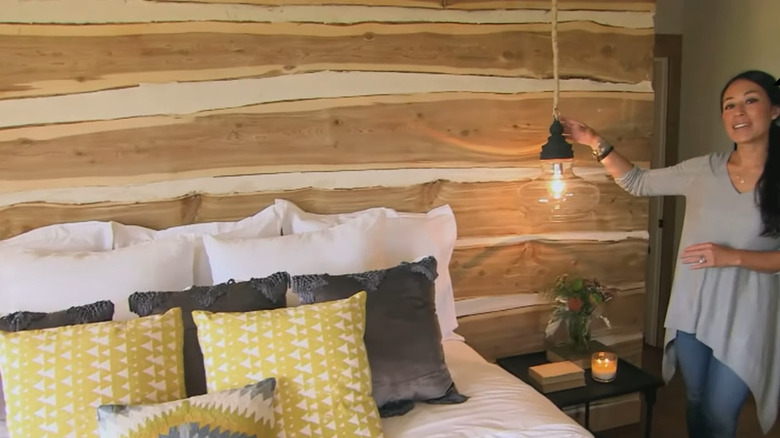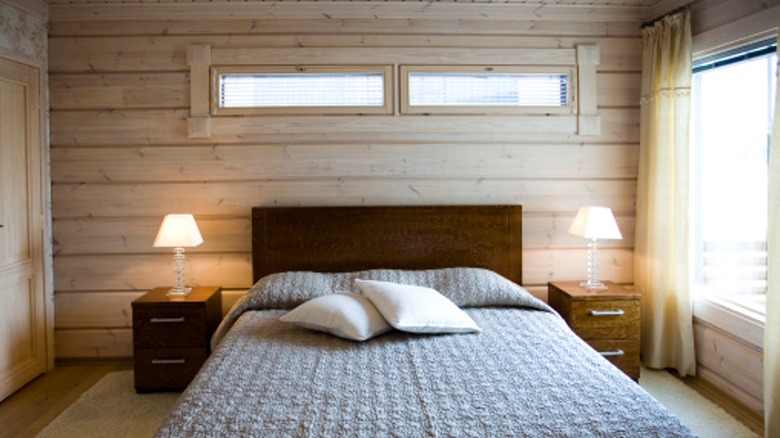Joanna Gaines Shows Us The Perfect Way To Add Gorgeous Texture To Any Bedroom
Interior designer and co-creator of the Magnolia Network Joanna Gaines is an excellent resource if you need inspiration for stunningly beautiful rooms that are also cozy and comfortable. Her choice of materials is a huge factor in her design, melding old with new, rough with soft, and rustic with refined. This is readily apparent in Season 3, Episode 8 of her and her husband Chip Gaines' HGTV show "Fixer Upper," in which Joanna transforms a rather uninspiring master suite into a charming, rustic cabin retreat with subtle Southwest accents. The highlight of the room is undoubtedly the cedar-planked accent wall. Gaines achieved its time-worn charm by expertly arranging irregular wood slabs and augmenting them with strips of stucco filler.
This unique accent wall complements similar wood trim on the room's windows and doors and creates a gorgeous contrast with the vintage, industrial-style pendant lights above the bedside tables. The high-impact wall provides a focal point in the room that backs the bed and draws the eye, while Gaines' combination of darker wood with the lighter stucco reinforces the room's rustic, age-worn feel. As she says in the episode, "This wall just adds a lot of texture and dimension in the space."
The benefits of a wood-paneled accent wall
Using wood paneling to create an accent wall is a great way to make a blank, white space more visually interesting. While this design feature may conjure images of 1970s basements or the full timbers of a log cabin, wood paneling is actually coming back in style thanks to its versatility. The effect can read as either modern or rustic depending on the cut, variety, and placement of the boards — fluted paneling can even improve your home's acoustics. Joanna Gaines frequently uses paneling in her designs, including the more popular option, shiplap, which is present in many of her modern, farmhouse-inspired spaces. In the "Fixer Upper" episode, Gaines' accent wall resembles a more primitively constructed wood-framed cabin, which adds a sense of age to the space that complements the homeowners' desired Southwest influence.
The effect isn't just stylistic — it's also visual and tactile, adding another layer to the room's abundance of patterns and wood. Notably, it also provides a brand-new sense of warmth. The panels' horizontal orientation also creates the illusion of a wider, larger room, much like the way vertical paneling can make a ceiling seem much higher than it actually is.
Is a wood accent wall right for your home?
While Joanna Gaines' design in "Fixer Upper" is striking (and perfect for her clients' aesthetic and home style), this rustic version of a wood-paneled accent wall may not be the right choice for many interiors, especially those that lean more modern or minimalist. The horizontal orientation can make a low ceiling seem even lower, while the sheer number of horizontal lines can quickly overwhelm a space with contrasting visual elements. A great solution to these problems is a paneling style with less visible lines and more uniform cuts, thereby creating interest and texture without demanding the whole room's attention. This type of paneling can easily add a timeless flair to your bedroom or living room.
While many kinds of paneling are perfect for DIY installation, keep in mind that wood paneling of this variety is often best left to professional contractors. Structural considerations must be made when adding heavy materials — like solid cedar planks and stucco — to existing drywall. The additional weight can significantly impact the integrity of the wall itself and the surrounding floor. Like with shiplap, improper panel installation (particularly on an exterior wall) can create moisture problems resulting in bowing, cracking, mold, and other kinds of damage.


